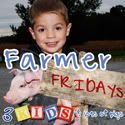Welcome to a special guest post edition of Farmer Fridays.
Hi, this is Meggie from over at Hoosier Farm Babe Tell Tails, where I blog about living and loving life on a hog and grain farm with my hubby Big D and our darling daughter Baby RayRay (hey I’m allowed to be biased!). And I’m proud to say that we are the 5th and 6th generations on Big D’s side and mine to farm BOTH of our family’s farmland (in Indiana and Ohio, respectively.) Yes … we haul our equipment back in forth between two states. Some call us a little crazy – but I figure we’re young and if we have the time and desire to do it – we might as well. For Big D and I, it is important to continue the family tradition, and if possible, ensure that opportunity can be made available to our children someday if they so choose.
Officially, it is spring here in the Midwest (yay for warmer weather!) and for this Real Farmwife of America, that means it’s time to start cooking to-go dinners or picking up take-out for the boys in the fields just about every evening for the next couple weeks. But we’re not there quite yet …way too many April showers for that to happen.
Just as many of you are gearing up to get in your gardens and get your hands a little dirty – it’s really a very similar emotion here in our household. But in a way it’s sorta a year-round attitude and way of life.
In fact, preparation for spring planting actually starts in the fall when Big D assesses what worked and what didn’t work and comes up with a planting POA or plan of action!
So how do we make these sorts of planting decisions – specifically what seed where, what kind and why?
First, we decide what crop we want to plant in what field. In our case, it’s either corn or soybeans. We’re pretty focused on corn because we need that grain to feed our hogs. Did you know that around 50 percent of the U.S. corn crop is grown to feed livestock, while the remainder ends up in foods such as corn chips or fuel such as ethanol.
 |
| Very soon we will plant this bag of seed corn. All of the corn on our farm is grown for use as livestock feed, not corn chips or other food products made from corn. |
 |
| Our seed is actually delivered to our farm in these fancy Pioneer Proboxes. There are around 55 bags of seed in every Probox. |
 |
| Stacks upon stacks of Proboxes at our seed salesman's farm. Wowsers!! |
 |
| Our seed salesman. As sort of younglings in our industry, it is great to have such good relationships with the folks we do business with. |
 |
| Well of course Baby RayRay is involved in the process. After all, we wouldn't do what we do if it wasn't to ensure the same opportunities can be made available to her someday! |
 |
| Pioneer seed bags- amazing that in North America there are over 400 different varieties of corn seed. |
 |
| Big D during the first year we started farming on our won. Dirt and sweat drenched clothes with calloused hands and this farmer's still got a smile for me! :) |
Thanks for a great guest post, Meggie!













Great job explaining what it is we do. Tall Guy finished up the field he and his dad were working in, working ground that had be "ripped" or deep chisel plowed. No seeds in the ground yet. Hoping next week will start to warm up and dry up after a wet start. Good luck and be safe!
ReplyDeleteGlad to see Pioneer seed corn in your shed!!!
ReplyDeletewww.thisfarmfamilyslife.blogspot.com
Great post!
ReplyDeleteindeed a good post!!!
ReplyDelete